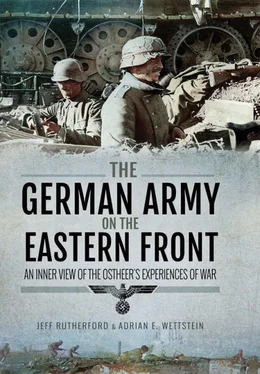4) Spare parts supply
The increasing decline in spare parts supply was a decisive factor in the maintenance of motor vehicles. The distances to the army motor vehicle depots were – like all supply routes – so large that the tours there could only be undertaken exceptionally. The stockpiles in the army motor vehicle depots themselves were extremely small in relation to demand, so that the workshop company was compelled to make spare parts itself in a makeshift manner and with great expenditure of time. On the other hand, motor vehicles were lost because the required spare part, which could not be procured by any means, was missing. In this way, motor vehicles whose general condition by no means justified being out of commission nonetheless had to be written off. Replacement engines were obtained only to a small extent, so a lack of suitable tow vehicles resulted in numerous motor vehicles left as total losses. These were cannibalized in the interests of the motor vehicles still in operation.
5) Reorganization of the division
As a result of the high personnel losses, the division was forced to dissolve an infantry regiment except for one battalion on 17.8. The largest motor vehicle gaps could be compensated for by the motor vehicles which were thereby released.
Not even two months into the campaign, the combined effects of an under-strength motor vehicle park consisting of vehicles generally not suited for the conditions in the east, the high demands on those motor vehicles, and structural problems such as the lack of spare part depots and maintenance and towing capacities, eroded German motor transport capabilities. This had severe consequences for units’ supply, as well as for their mobility. Only the reduction of unit size could close the most urgent gaps.
6) Reconditioning during the operation in the Dnipropetrovsk bridgehead and captured motor vehicles
During the operations in Dnipropetrovsk bridgehead, which led to stable conditions for the maintenance of motor vehicles, it was possible for the division during the four-week period of the fighting to catch-up with the neglect of the motor vehicle maintenance during the advance. During this time not only had the 235th Workshop Company repaired up to 120 motor vehicles per week, but the troops’ provisional maintenance units have also carried out a great deal of repair work in an outstanding manner, so that the number of vehicles in repair fell noticeably and only those repairs which lacked the necessary spare parts for completion remained unfinished. In recognition of the difficult motor vehicle situation, especially of the supply services, First Panzer Army and IIIrd Motorized Corps, already helped the division in the last period of advance and combat with the temporary allocation of corps [supply] columns and the bringing of supplies in close proximity. […] At the conclusion of the battles in the Dnipropetrovsk bridgehead, which brought high losses for the division, the division succeeded in capturing some motor vehicles. Here, amongst others, 10 tractors were seized, which could be made operational by the workshop company over the course of time. […] The number of missing vehicles at this time after the inclusion of the motor vehicles supplied from the army motor vehicle depot, private purchases and seized goods amounted to 42 motorcycles, 77 sidecar motorcycles, 6 passenger cars, 49 trucks, 1 bus, 10 special vehicles and 6 motor ambulances. 40% of the total losses resulted from enemy action.
In August, most German advance axes experienced operational stops of varying lengths as a consequence of exhaustion and growing supply problems. This was expected by the military leadership, but it was presumed that the Red Army was beaten at that time. Fighting in most areas, such as the previously mentioned Dnipropetrovsk bridgehead, instead confronted the Germans with a different reality. Instead of pausing and filling up the depots for a second operational phase, German forces were involved in hard, supply-consuming combat. Only minor reserves of supply goods could be accumulated in depots near the front. Maintenance of vehicles also suffered. With the imminent worsening of road conditions due to the upcoming autumn rains, the prospects for future operations were dire. Massive breakdowns could be expected to occur, as the next section indicates:
7) Losses during the march from the Pavlovka-Snamenka area to Makejevskoj
How much the division’s motor vehicles were wasted, however, was reflected in the catastrophic impact of the march from the Pavlovsk– Snamenka area to Makejewoskj (380km). Together with a slight frost, heavy rains had softened the roads and made them so impassable, that all motor vehicle traffic had to be stopped. During this period, the division was compelled by orders of First Panzer Army to proceed with the march with foot and horse drawn troops, without regard for the motorized sections and supply units, so that the troops were increasingly distant from the division’s supply basis. Despite the strong wind, the drying out [of the roads] lasted a long time as a result of a constant alternation between frost and rain so that it was not possible to wait for the road conditions to be completely suitable for motor vehicles. As far as possible, the marches were carried out during the night and early morning hours, when the frozen ground still gave motor vehicles a hold. Since motor vehicle traffic was generally tremendously heavy due to the standstills that lasted for days, this condition constituted only a temporary improvement; the motor vehicles had to cut their way through mud and morass partly on and partly next to the roads. The motor vehicle material was no longer able to cope with such a high strain. Thus, 21 motorcycles, 10 sidecar motorcycles, 18 passenger cars, 17 trucks, 4 motor ambulances and 1 bus fell out on the 380km-long route, though these figures did not constitute a final result as the march movement had not yet been completed due to further rain. As a result, the number of missing vehicles has risen to a total of 61 motorcycles, 87 sidecar motorcycles, 24 passenger cars, 66 trucks, 10 motor ambulances, [and] 2 buses. Not included in this figure remain the numerous motor vehicles, which broke down on this route, have been sent to maintenance, and are not yet operational again. In order to collect these fallen out vehicles, two motor vehicle collection points were set up in Novo-Nikolayevka and Guljaj Pole, where the division’s workshop platoon was deployed to work. During the march of the motorized sections on this 380km-long impassable route, the tractors captured in Dnipropetrovsk rendered invaluable services in collecting the broken vehicles. Without them, the losses undoubtedly would have been much greater.
8) Losses of the fuel [supply] column
For example, the long and poor supply routes had a particularly strong effect on the fuel column’s truck inventory. It was assigned to the division in December 1940 with 7 Magrius trucks built in the years 1936/38 and 4 Chevrolet trucks manufactured in 1939. The last-named trucks were traded for 2 Ford, 1 Opel and a MAN truck in the exchange action. By 16.8.41, all the trucks swapped by the 253th Infantry Division and a Magrius truck had already broken down because of engine and differential damage and due to general wear and tear. On 30.8., 3 further Magrius trucks and 2 Ford trucks newly allocated in the meantime were lost. On 20.9., two trucks were loaded [on a train] for repair in the army motor vehicle park in Breslau. The last truck was a total write-off at the beginning of September because of a broken frame and bearing failure. In the case of the column’s Magrius trucks, these were commercial trucks formerly used as long distance lorries, which had already driven more than 100,000 kilometres when they were assigned to the column, and in this state they were involved in the campaigns in the West, in the Balkans and in the East. For instance, one of the trucks written off on the basis of general wear and tear, manufactured in 1937, had a kilometre reading of 400,000km.
Читать дальше






![John Stieber - Against the Odds - Survival on the Russian Front 1944-1945 [2nd Edition]](/books/405234/john-stieber-against-the-odds-survival-on-the-russian-front-1944-1945-2nd-edition-thumb.webp)





